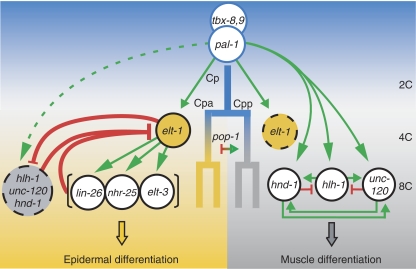Figure 6.
A model for the C lineage developmental regulatory network. A model for how pal-1 robustly specifies and patterns multiple cell fates. The expression and inferred regulatory interactions among C lineage TFs in only the posterior C daughter and its immediate descendants are shown, but the model is the same for the anterior C daughter. PAL-1 and TBX-8,9 initiate C blastomere development, inducing first elt-1 such that ELT-1 is present in all cells at the 4C stage. In the daughters of the anterior cell (8C stage), ELT-1 continues to be expressed and is active, inducing the second stage epidermal TFs and repressing the muscle module. In the posterior daughter cell, ELT-1 expression is not maintained and all three muscle module TFs are strongly activated, rapidly leading to a self-sustaining (inducer independent) expression state—the presented muscle module topology is one of the several self-sustaining topologies consistent with the data (see text). The TF POP-1 is asymmetrically deployed in these anterior-posterior daughters at the 4C stage, but it is unknown whether POP-1 represses muscle development in the anterior daughter cells and/or activates muscle module expression in posterior daughter cells. POP-1 and/or its regulators may also influence ELT-1 activity.

